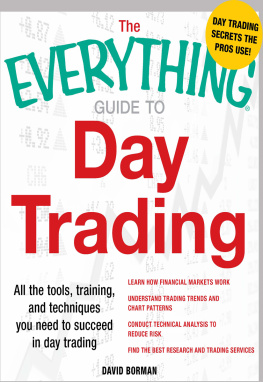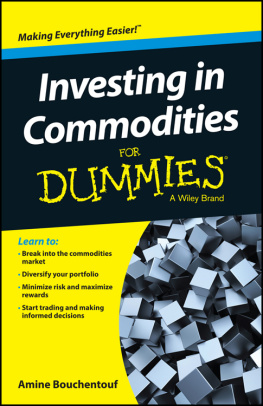THE

GUIDE TO
COMMODITY TRADING
Dear Reader,
If you are a typical investor, you will get much out of this book. You will learn the best way to make money buying commodities ETFs (exchange traded funds), how to build your own commodities portfolio, and how to evaluate commodities-based mutual funds. Some real differences between this book and others are that Ive both bought and sold commodities as an investor and as a dealer. Ive worked as a gold and silver bullion dealer in the past. Because of this, Ive had the rare chance to hold 1-kilo bricks of pure 24-karat gold in my hands and stack them up in a safe. Ive heaved 5-gallon pails filled with 100-ounce pure silver bars out to the backseat of investors cars while they paid cash for the metal at the counter. Add real experience with scrapping out gold-filled pocket watches, sterling silver, and sorting old pennies to trading paper investments such as leveraged oil and copper ETFs and commodities currencies, and Ive brought you the real honest-to-goodness knowledge and enthusiasm that I bring to my own investing and trading.
Welcome to the rewarding world of commodities trading!

Welcome to the  Series!
Series!
These handy, accessible books give you all you need to tackle a difficult project, gain a new hobby, comprehend a fascinating topic, prepare for an exam, or even brush up on something you learned back in school but have since forgotten.
You can choose to read an Everything book from cover to cover or just pick out the information you want from our four useful boxes: e-questions, e-facts, e-alerts, and e-ssentials. We give you everything you need to know on the subject, but throw in a lot of fun stuff along the way, too.
We now have more than 400 Everything books in print, spanning such wide-ranging categories as weddings, pregnancy, cooking, music instruction, foreign language, crafts, pets, New Age, and so much more. When youre done reading them all, you can finally say you know Everything!

PUBLISHER Karen Cooper
MANAGING EDITOR, EVERYTHING SERIES Lisa Laing
COPY CHIEF Casey Ebert
ASSISTANT PRODUCTION EDITOR Melanie Cordova
ACQUISITIONS EDITOR Lisa Laing
ASSOCIATE DEVELOPMENT EDITOR Hillary Thompson
EDITORIAL ASSISTANT Matthew Kane
EVERYTHING SERIES COVER DESIGNER Erin Alexander
LAYOUT DESIGNERS Erin Dawson, Michelle Roy Kelly, Elisabeth Lariviere
Visit the entire Everything series at www.everything.com

GUIDE TO
COMMODITY
TRADING
All the tools, training, and techniques you need to succeed in commodity trading
David Borman, Author of The Everything Guide to Day Trading

This book is dedicated to all those who have
struggled to finish a manuscript on time: the
early mornings, the late nights, the cups of
coffee, and the endless frozen pizzas.
Contents
Acknowledgments
I would wholeheartedly like to thank my editor Lisa Laing, who gave me first, second, and third chances with the completion of this book. I would also like to thank all of the people who are out there skimming through investing books, and who stumble upon mine and decide to buy them. Lastly, Id like to thank my mother, Cynthia, who spent the final weeks of this book in combat mode, both of us loading up on frozen pizzas and diet root beer, right to the end.
Top 10 Things Every Commodities Investor Should Know
- Buy gold on Monday mornings: Gold prices usually go down on Monday mornings.
- U.S. pennies dated 1982 and older are 95 percent copper and are worth about 3 cents each (at this writing).
- A 3 leveraged crude oil ETF will go up 300 percent more than a regular oil ETF.
- Central banking websites are the best sources of inflation information.
- Inflation, money supply, and a good economy make commodity prices rise.
- When economic news is bad, gold and oil will go up, while silver and copper will go down.
- Crude oil, gasoline, heating oil, and gold prices are seasonal.
- Consider investing indirectly with stocks and mutual funds if you are a conservative investor.
- Consider trading futures or buying private placement offerings if you are an aggressive investor.
- Know that an investment cycle lasts seven years or longer and investing in commodities puts you at the beginning of one of these seven year cycles, allowing you to ride the price wave to its peak.
Introduction
COMMODITIES HAVE BEEN ESSENTIAL to the financial well-being of people and economies for thousands of years. Since the days of the Egyptians, grains were bought from other lands and shipped to the cities for the citizens to bake bread. Gold was used on the mask of King Tut, and copper was used on the tips of the kings swords.
Later, gold and silver were used as money, which continues to this day. Grains, wool, and cotton have been grown in areas that had fertile soil, and today some countries such as New Zealand earn a great deal by shipping these raw materials to other countries that need these commodities.
Commodities have been brought to light again in this day, and this is mainly due to the economic conditions that were brought about since the banking and housing crisis of late 200709. Due to the near collapse of the worlds economies, many of the largest central banks of the world went to extraordinary measures to insure the recovery of the fragile banking system and household economies.
Some of the measures taken were rapid decreases in base interest rates, with some rates being brought down to near zero percent. Other measures taken were the ramping up of the money supply in the United States, Japan, and Great Britain. These measures were called such interesting names as quantitative easing (QE1), quantitative easing 2 (QE2), QE3, and Operation Twist.
These elements alone would lead you to believe that it is a good time to buy commodities and have a commodities position in your portfolio. If you take this information and add to it the fact that the economy is just teetering at the end of a recession and just about to exit the past slowdown, well, then you have an excellent time to get into commodities trading!
This can be good if you are ready and prepared for the upcoming rise in prices. It may be that you would like to accent your overall investment portfolio to include a higher percentage of gold and oil ETFs with a base amount invested in a broad-based commodities mutual fund.














